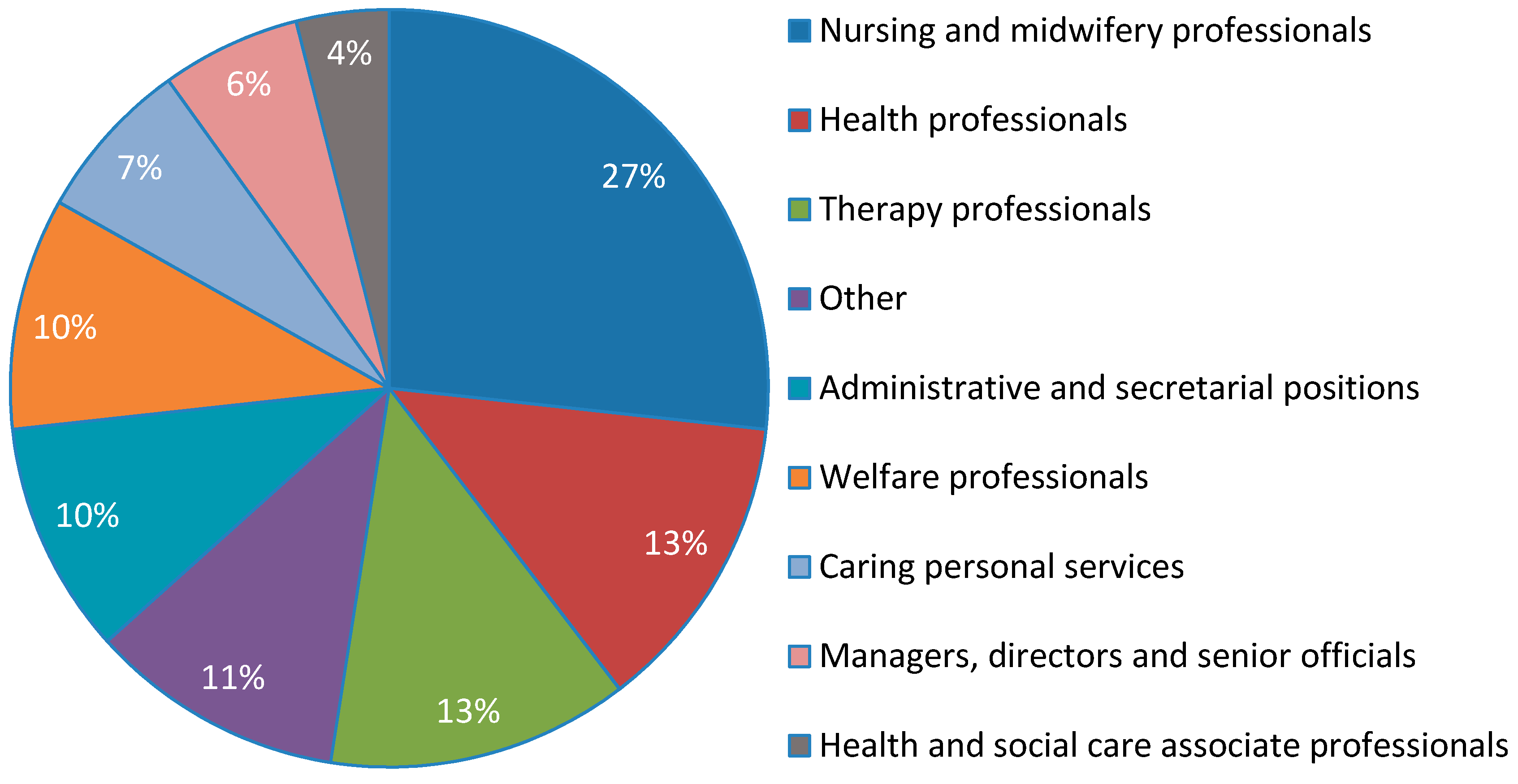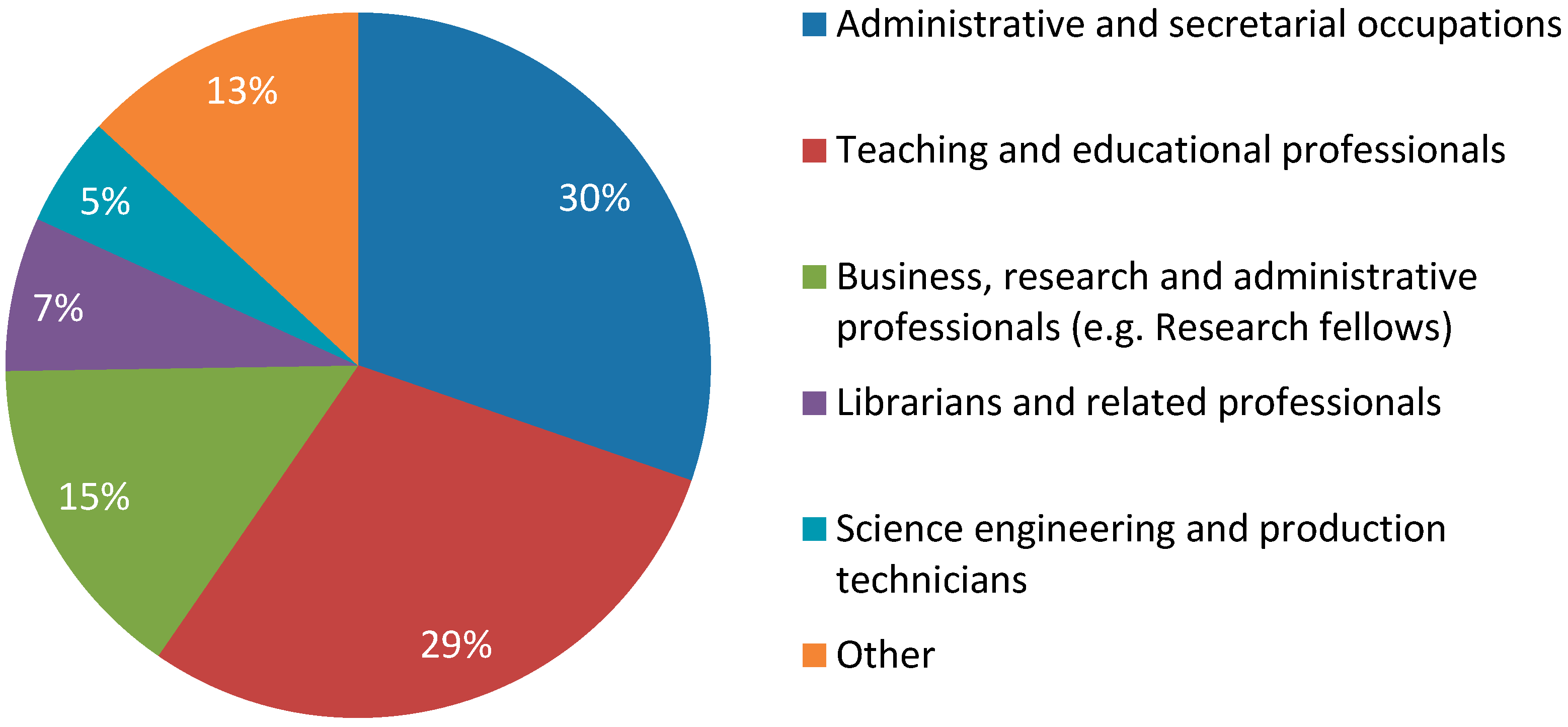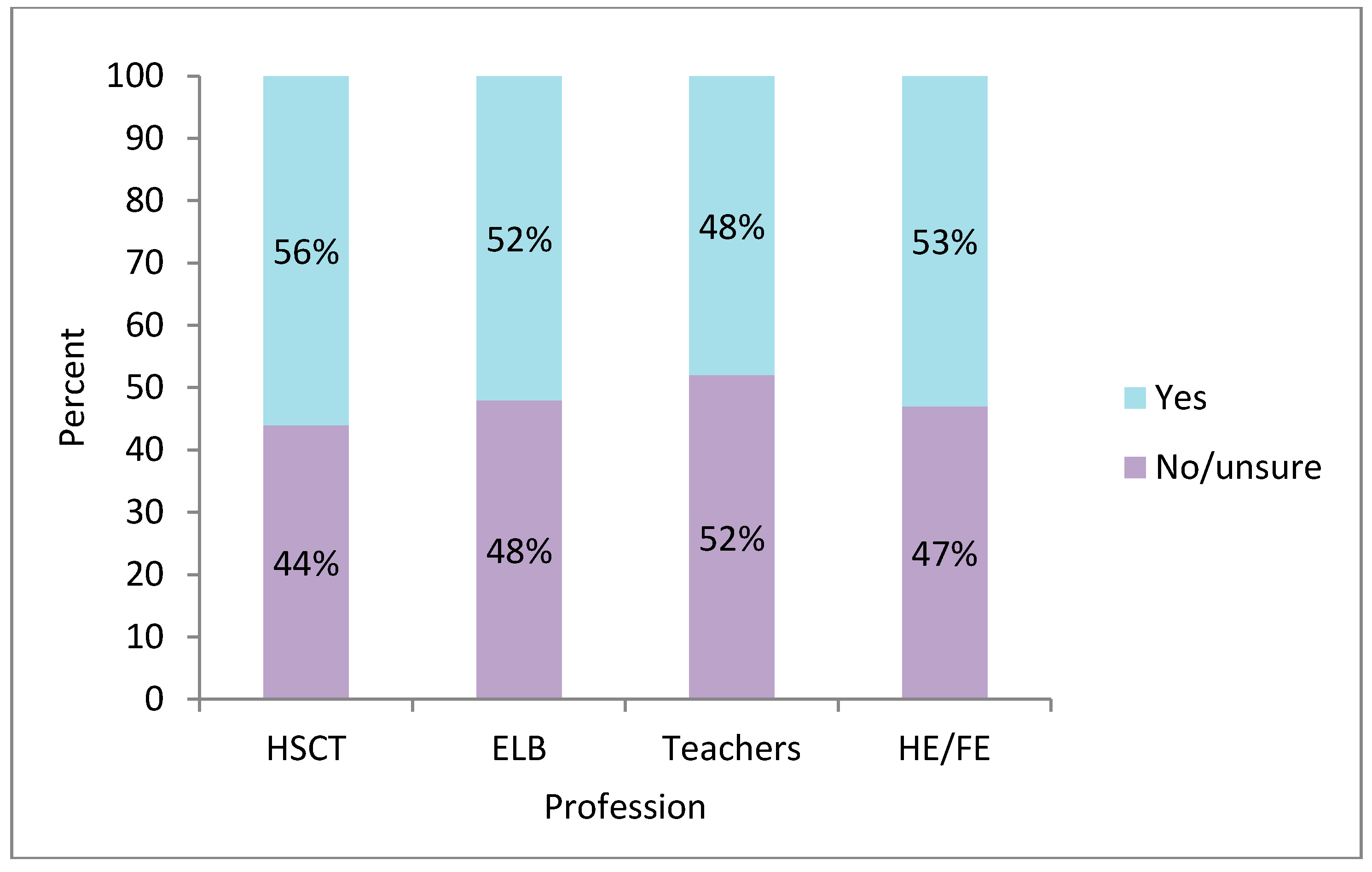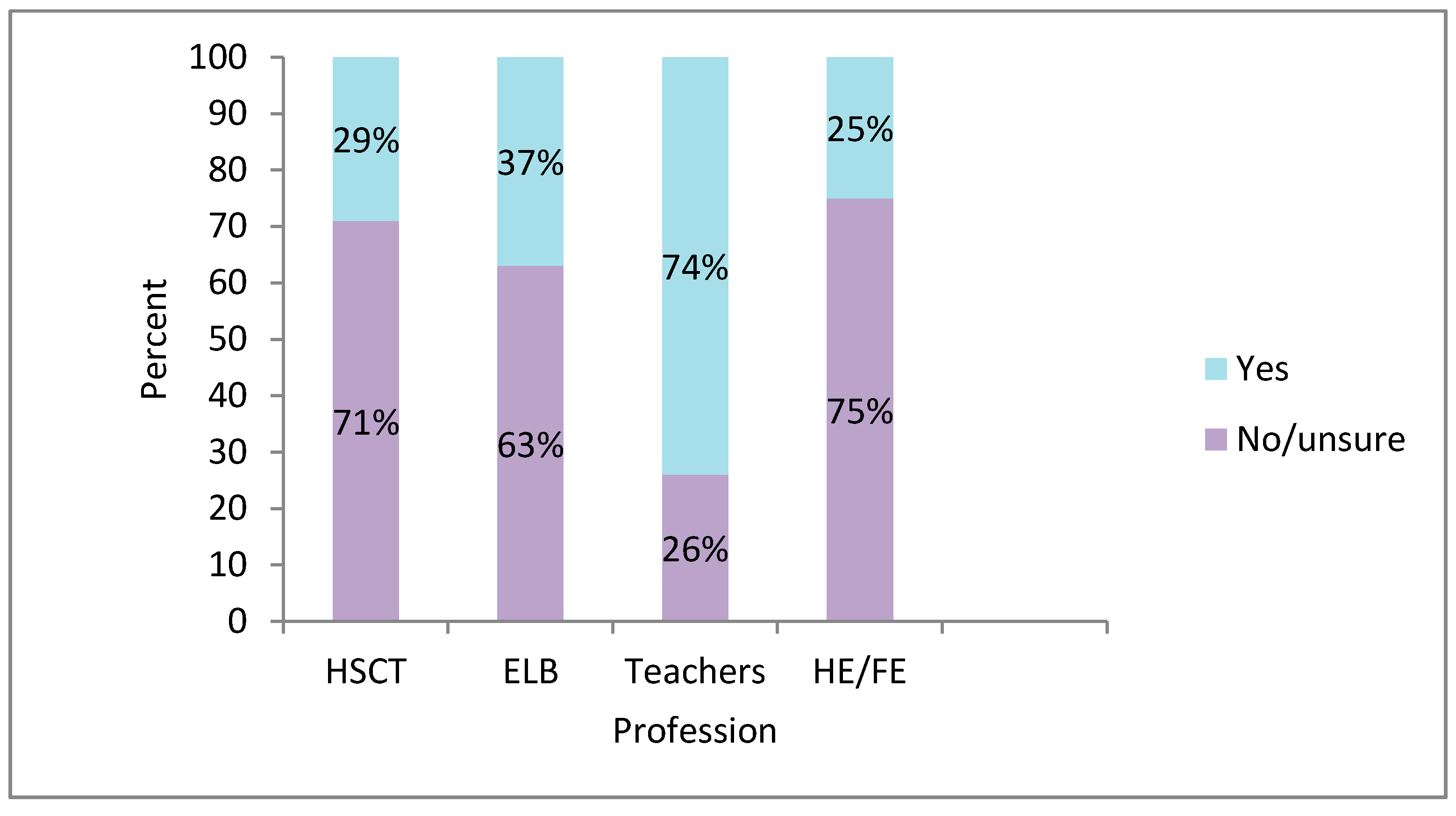Staff Training in Autism: The One-Eyed Wo/Man…
Abstract
:1. Introduction
2. Methodology
2.1. Participants
2.1.1. Survey Participants
2.1.2. Interview Participants
- Five adults with autism (three men and two women) aged 18+ years of age;
- 14 parents/caregivers (including two couples); the son(s)/daughter(s) of five of these parents were teenagers or young adults with autism; the son(s)/daughter(s) of the other nine parents were younger;
- 12 education professionals; three of the education professionals were parents of son(s)/daughter(s) with autism, while nine of the education professionals did not have a child of their own with autism.
2.2. Research Instruments
- Level /Tier 1 equates to brief autism awareness sessions, usually lasting no more than 1–2 h aimed at general autism service providers and other frontline staff.
- Level/Tier 2 usually takes the form of a half-day seminar aimed at staff who work directly with a child or adult with autism.
- Level/Tier 3 commonly takes 1–2 days and is aimed at building on existing knowledge for staff who are taking a lead in autism service provision.
2.2.1. Professional Online Surveys
2.2.2. Semi-Structured Interviews
2.3. Research Procedures
2.3.1. Professional Online Survey
2.3.2. Semi-Structured Interviews
2.4. Data Analysis
2.5. Ethics Statement
3. Results
3.1. Professional Autism Knowledge and Training
‘My mum and dad would have been good [for support], but my mum has recently been diagnosed with Alzheimer’s, and my dad, he goes into hospital every second week for treatment…so really, we don’t leave the kids with them at all now. And my sister, she’s got fibromyalgia. Her younger son, he’s got Asperger’s and the younger daughter, she’s not diagnosed but we’re pretty certain she’s got autism as well. She’s got enough going on in her house [without helping us].’(Adult A’s wife)
‘Yes, at times I’ve had to tell [wife] to just leave him alone. I’m like ‘Just leave him’ …and you just wait until he calms down, and tell him what he’s done wrong, he’s got to fix whatever he’s done…but at the same time, I probably don’t let him away with as much as [wife] will.’(Adult A)
‘I feel training and updates should be mandatory as we encounter people with autism frequently as service users and some colleagues.’(HSC participant)
‘I think it should be included in basic nursing training. We are not always made aware when referrals are put through that there has been a diagnosis of autism and training would assist us to recognise it.’(HSC professional)
‘Better training for staff working in mental health services on working with people with autism. This is important as Asperger’s Syndrome now falls within mental health services, whereas previously this came under learning disability services.’(HSC professional)
3.2. Service User Views about Staff Training
‘I went and saw the GP [General Practitioner], and I said to the GP ‘I believe I’m autistic, because of [son]’s diagnosis, that I match up quite a bit to how he is, and stuff.’(Adult A)
’…so the GP was like ‘we’ll try and get you someone to see in the Psychology department’ and he says ‘but I daren’t put autism down because they might just simply say “Oh, we don’t diagnose for that”, and you wouldn’t get seen for any trouble’, so it took a long time for that…(Adult A)
‘The GP wrote off…but suggested that because I was married and had a job there was ‘No hope [of a diagnosis]’…I took an ADOS8 test, and an IQ test. They said ‘no’…I took the whole day off work to attend [HSC clinic]. [HSC diagnostician] said, if I had Asperger’s I wouldn’t have done that, but I was so anxious…’(Adult D)
‘The autism service in [education authority] wouldn’t talk to the parent or the child, only to the school. Teachers at school just don’t understand…Girls have a different profile, so you have autism, and Asperger’s, and Asperger girls etc…The multidisciplinary teamwere failing to protect my child.’(Parent of teenage daughter with autism)
‘Yes, we suspected from about 15 to 18 months that [name] had autism. It took us quite a while to get her on to the waiting list to be diagnosed, so we actually took her privately ourselves…[t]hen we got her on to the waiting list to be diagnosed’(Parent of preschool daughter with autism)
‘Initially I didn’t sort of go seeking diagnosis immediately…it probably wouldn’t be from the point of view of seeking further services or intervention.’(Adult B)
‘Yes, I still have my therapist…she has been with me for maybe 2 or 3 years…and she can keep an eye, she can support me.’(Adult C)
‘I think there probably is a significant unmet demand, including among people who have a much greater need for services or support than I would.’(Adult B)
‘…there’s a thing they should do, get autism dentists!…Our dentist said ‘I cannot deal with that’ and referred us to this private dentist, and we thought it would be a couple of hundred pounds…£600 I think he charged us, for fillings and X-rays, he gave him like a whole work-up once he got us in there.’(Parent of two young adults with autism)
‘I’ve heard tell there are such things as disability social workers, I think they’re as rare as hen’s teeth, I think that would probably be of benefit.’(Adult A’s wife)
‘…there’s a cut-off age, she would no longer be his social worker, once he reached 16, but I don’t remember seeing [name] the last year, it might even have been [since he was] 14, or 12…because when he got to a certain age, she no longer was his social worker, because he didn’t fit the criteria.’(Parent of adult daughter with autism)
‘The contrast between what happens pre-19 and post-19 is a total disgrace, total disgrace… Shocking- the money just stops, and everything stops and [son] had severe mental health problems from when he knew he had to leave school…and then everything else dried up, all the money for his social life, everything.’(Parent of adult son with autism and severe learning disabilities)
4. Discussion
5. Conclusions
Author Contributions
Conflicts of Interest
References
- Benchmarking Autism Service Efficacy (BASE) Project. Available online: http://www.qub.ac.uk/research-centres/CentreforBehaviourAnalysis/Research/BenchmarkingAutismServiceEfficacyBASE/ (accessed on 2 April 2016).
- Centers for Disease Control and Prevention (CDC). Autism Spectrum Disorder (ASD): Data and Statistics. Available online: http://www.cdc.gov/ncbddd/autism/data.html (accessed on 28 January 2015).
- Kim, Y.S.; Leventhal, B.L.; Koh, Y.-J.; Fombonne, E.; Laska, E.; Lim, E.-C.; Cheon, K.-A.; Kim, S.-J.; Kim, Y.-K.; Lee, H.; et al. Prevalence of autism spectrum disorders in a total population sample. Am. J. Psychiatry 2011, 168, 904–912. [Google Scholar] [CrossRef] [PubMed]
- Department of Health Social Services and Public Safety (DHSSPS). The Prevalence of Autism (Including Asperger’s Syndrome) in School Age Children in Northern Ireland 2016. Available online: https://www.health-ni.gov.uk/publications/prevalence-autism-including-asperger%E2%80%99s-syndrome-school-age-children-northern-ireland-1 (accessed on 2 March 2016).
- Dillenburger, K.; Jordan, J.A.; McKerr, L.; Keenan, M. The Millennium child with autism: Pre- and post-diagnosis health and quality of life. Dev. Neurorehabil. 2014. [Google Scholar] [CrossRef]
- Dillenburger, K.; Schubolz, D.; McKerr, L.; Jordan, J.-A. Young Life and TImes Survey: Autism module. Available online: http://www.ark.ac.uk/ylt/ (accessed on 4 September 2014).
- Brugha, T.S.; McManus, S.; Bankart, J.; Scott, F.; Purdon, S.; Smith, J.; Bebbington, P.; Jenkins, R.; Meltzer, H. Epidemiology of autism spectrum disorders in adults in the community in England. Arch. Gen. Psychiatry 2011, 68, 459–465. [Google Scholar] [CrossRef] [PubMed]
- American Psychological Association (APA). Diagnostic Statistical Manual (DSM-5). Am. J. Psychiatry 2013. [Google Scholar] [CrossRef]
- Close, H.A.; Lee, L.-C.; Kaufmann, C.N.; Zimmerman, A.W. Co-occurring Conditions and Change in Diagnosis in Autism Spectrum Disorders. Pediatrics 2012, 129, e305–e316. [Google Scholar] [CrossRef] [PubMed]
- Zablotsky, B.; Anderson, C.; Law, P. The association between child autism symptomatology, maternal quality of life, and risk for depression. J. Autism Dev. Disord. 2013, 43, 1946–1955. [Google Scholar] [CrossRef] [PubMed]
- Dillenburger, K.; McKerr, L.; Jordan, J.-A. Lost in translation: Public policies, evidence-based practice, and Autism Spectrum Disorder. Int. J. Disabil. Dev. Educ. 2014, 61, 134–151. [Google Scholar] [CrossRef]
- Dillenburger, K. The emperor’s new clothes: Eclecticism in autism treatment. Res. Autism Spectr. Disord. 2011, 5, 1119–1128. [Google Scholar] [CrossRef]
- Howlin, P.; Savage, S.; Moss, P.; Tempier, A.; Rutter, M. Cognitive and language skills in adults with autism: A 40-year follow-up. J. Child Psychol. Psychiatry 2014, 55, 49–58. [Google Scholar] [CrossRef] [PubMed]
- Howlin, P.; Goode, S.; Hutton, J.; Rutter, M. Adult outcome for children with autism. J. Child Psychol. Psychiatry 2004, 45, 212–229. [Google Scholar] [CrossRef] [PubMed]
- Sheehan, R.; Hassiotis, A.; Walters, K.; Osborn, D.; Strydom, A.; Horsfall, L. Mental illness, challenging behaviour, and psychotropic drug prescribing in people with intellectual disability: UK population based cohort study. Br. Med. J. 2015. [Google Scholar] [CrossRef] [PubMed]
- Khanna, R.; Jariwala-Parikh, K.; West-Strum, D.; Mahabaleshwarkar, R. Health-related quality of life and its determinants among adults with autism. Res. Autism Spectr. Disord. 2014, 8, 157–167. [Google Scholar] [CrossRef]
- Muhle, R.; Trentacoste, S.V.; Rapin, I. The genetics of autism. Pediatrics 2004, 113, e472–e486. [Google Scholar] [CrossRef] [PubMed]
- Hirvikoski, T.; Mittendorfer-Rutz, E.; Boman, M.; Larsson, H.; Lichtenstein, P.; Bölte, S. Premature mortality in autism spectrum disorder. Br. J. Psychiatry 2015, 5. [Google Scholar] [CrossRef] [PubMed]
- Silberman, S. Neurotribes: The Legacy of Autism and How to Think Smarter about People Who Think Differently; Allen & Unwin: Crows Nest, New South Wales, Australia, 2015. [Google Scholar]
- Keenan, M.; Gallagher, S.; Booth, N.; Dillenburger, K.; Moxon, P. Challenging Behaviour. Available online: http://challengingbehaviour.peatni.org/ (accessed on 1 May 2016).
- Keenan, M. Evidence Based Practice and Autism: A Political Minefield. Available online: https://www.youtube.com/watch?v=LFVykFNOGdw (accessed on 14 February 2015).
- Casey, L.B.; Zanksas, S.; Meindl, J.N.; Parra, G.R.; Cogdal, P.; Powell, K. Parental symptoms of posttraumatic stress following a child’s diagnosis of autism spectrum disorder: A pilot study. Res. Autism Spectr. Disord. 2012, 6, 1186–1193. [Google Scholar] [CrossRef]
- Eikeseth, S.; Gale, C. Stress in parents of children with autism participating in early and intensive behavioral intervention. Eur. J. Behav. Anal. 2015, 16, 112–120. [Google Scholar] [CrossRef]
- Harris, J.; Lord, C. Mental health of children with vision impairment at 11 years of age. Dev. Med. Child Neurol. 2016, 58, 774–779. [Google Scholar] [CrossRef] [PubMed]
- Munteanu, C.; Dillenburger, K. Family functioning during the diagnosis process in families with children on the autism spectrum. Ter. Sist. Syst. Ther. 2009, 3, 1–17. [Google Scholar]
- Dillenburger, K.; McKerr, L. ‘40 Years is an awful long time’: Parents caring for adult sons and daughters with disabilities. Behav. Soc. Issues 2009, 18, 1–21. [Google Scholar] [CrossRef]
- Dillenburger, K.; McKerr, L. ‘How long are we able to go on?’ Issues faced by older family caregivers of adults with disabilities. Br. J. Learn. Disabil. 2011, 39, 29–38. [Google Scholar] [CrossRef]
- Keenan, M.; Dillenburger, K.; Doherty, A.; Byrne, T.; Gallagher, S. Meeting the Needs of Families Living with Children Diagnosed with Autism Spectrum Disorder. Available online: http://www.lenus.ie/hse/bitstream/10147/45853/1/9394.pdf (accessed on 10 April 2016).
- Buescher, A.V.S.; Cidav, Z.; Knapp, M.; Mandell, D.S. Costs of Autism Spectrum Disorders in the United Kingdom and the United States. JAMA Pediatr. 2014, 168, 721–728. [Google Scholar] [CrossRef] [PubMed]
- Knapp, M.; Romeo, R.; Beecham, J. Economic cost of autism in the UK. Autism 2009, 13, 317–336. [Google Scholar] [CrossRef] [PubMed]
- Stewart, S. I Exist: The Message from Adults with Autism in Northern Ireland; The National Autistic Society Northern Ireland: Belfast, UK, 2008. [Google Scholar]
- Dillenburger, K.; Jordan, J.-A.; McKerr, L. School’s out forever: Postsecondary educational trajectories of students with autism. Aust. Psychol. 2016, in press. [Google Scholar]
- Cappadocia, M.C.; Weiss, J.A.; Pepler, D. Bullying experiences among children and youth with autism spectrum disorders. J. Autism Dev. Disord. 2012, 42, 266–277. [Google Scholar] [CrossRef] [PubMed]
- Dillenburger, K.; Jordan, J.-A.; McKerr, L. BASE Project (Volume 3): Seondary Data Analysis; Queen’s University Belfast: Belfast, UK, 2014. [Google Scholar]
- Fennell, B.; Dillenburger, K. Applied behaviour analysis: What do teachers of students with autism spectrum disorder know. Int. J. Educ. Res. 2016. under review. [Google Scholar]
- Parsons, M.B.; Rollyson, J.H.; Reid, D.H. Evidence-based staff training: A guide for practitioners. Behav. Anal. Pract. 2012, 5, 2–11. [Google Scholar] [PubMed]
- Reid, D.H.; O’Kane, N.P.; Macurik, K.M. Staff training and management. In Handbook of Applied Behavior Analysis; Fisher, W.W., Piazza, C.C., Roane, H.S., Eds.; Guilford Press: New York, NY, USA, 2011; pp. 281–294. [Google Scholar]
- Bond, C.; Symes, W.; Hebron, J.; Humphrey, N.; Morewood, G.; Woods, K. Educational interventions for children with ASD: A systematic literature review 2008–2013. Sch. Psychol. Int. 2016. [Google Scholar] [CrossRef]
- Dillenburger, K.; Röttgers, H.-R.; Dounavi, K.; Sparkman, C.; Keenan, M.; Thyer, B.; Nikopoulos, C. Multidisciplinary teamwork in autism: Can one size fit all? Aust. Educ. Dev. Psychol. 2014, 30, 1–16. [Google Scholar] [CrossRef]
- Spector, A.; Orrell, M.; Goyder, J. A systematic review of staff training interventions to reduce the behavioural and psychological symptoms of dementia. Ageing Res. Rev. 2013, 12, 354–364. [Google Scholar] [CrossRef] [PubMed]
- Van Oorsouw, W.M.W.J.; Embregts, P.J.C.M.; Bosman, A.M.T.; Jahoda, A. Training staff serving clients with intellectual disabilities: A meta-analysis of aspects determining effectiveness. Res. Dev. Disabil. 2009, 30, 503–511. [Google Scholar] [CrossRef] [PubMed]
- National Autistic Society (NAS). Autism Training Level/Tiers. Available online: http://www.autism.org.uk/our-services/education-services/autism-training-for-education-professionals/level-1.aspx (accessed on 23 November 2015).
- Behavior Analyst Certification Board. Available online: http://www.bacb.com (accessed on 3 May 2015).
- American Psychological Association (APA). PsycTESTS®. Available online: http://www.apa.org/pubs/databases/psyctests/ (accessed on 31 January 2015).
- Written Answers to Questions: Hansard AQW 41410/11-15. Available online: http://aims.niassembly.gov.uk/questions/searchresults.aspx?&qf=1&asb=0&tbm=0&anb=9&abp=0&sp=3&qfv=2&asbv=0&tbmv=1&anbv=82&abpv=0&spv=17&ss=y6WgsCwl8I0=&tm=2&per=1&sus=1&qs=1&ans=1&it=1&fd=&td=&pm=0&asbt=All Members&anbt=the Minister of Health&abpt=All Par (accessed on 2 April 2016).
- Dillenburger, K. Why Early Diagnosis of Autism in Children Is a Good Thing. Available online: https://theconversation.com/why-early-diagnosis-of-autism-in-children-is-a-good-thing-33290 (accessed on 14 February 2015).
- IBM. SPSS 13.0 Base User’s Guide®; IBM: Armonk, NY, USA, 2004. [Google Scholar]
- Braun, V.; Clarke, V. Using thematic analysis in psychology. Qual. Res. Psychol. 2006, 3, 77–101. [Google Scholar] [CrossRef]
- O’Reilly, M.; Karim, K.; Lester, J.N. Separating ‘emotion’ from ‘the science’: Exploring the perceived value of information for parents and families of children with autistic spectrum disorder. Clin. Child Psychol. Psychiatry 2015, 20, 500–514. [Google Scholar]
- Gaugler, T.; Klei, L.; Sanders, S.J.; Bodea, C.A.; Goldberg, A.P.; Lee, A.B.; Mahajan, M.; Manaa, D.; Pawitan, Y.; Reichert, J.; et al. Most genetic risk for autism resides with common variation. Nat. Genet. 2014. [Google Scholar] [CrossRef] [PubMed]
- Sandin, S.; Lichtenstein, P.; Kuja-Halkola, R.; Larsson, H.; Hultman, C.M.; Reichenberg, A. The familial risk of autism. JAMA 2014, 311, 1770–1777. [Google Scholar] [CrossRef] [PubMed]
- Lichtenstein, P.; Carlström, E.; Råstam, M.; Gillberg, C.; Anckarsäter, H. The genetics of autism spectrum disorders and related neuropsychiatric disorders in childhood. Am. J. Psychiatry 2010, 167, 1357–1363. [Google Scholar] [CrossRef] [PubMed]
- Bamford, D. Review of Mental Health and Learning Disability (NI). Available online: http://www.dhsspsni.gov.uk/index/bamford/published-reports.htm (accessed on 11 September 2011).
- Department of Health, Social Servcies and Public Safety (DHSSPS). Transforming Your Care. Available online: https://www.dhsspsni.gov.uk/topics/health-policy/transforming-your-care (accessed on 22 April 2016).
- Health and Safety Executive (HSE). Work Related Stress: Causes of Stress. Available online: http://www.hse.gov.uk/stress/furtheradvice/causesofstress.htm (accessed on 1 May 2016).
- Taylor, D. Death by PowerPoint. Dev. Med. Child Neurol. 2007, 49, 395. [Google Scholar] [CrossRef] [PubMed]
- General Medial Council (GMC). How We Monitor the Quality of Education and Training. The Quality Assurance Framework. Available online: http://www.gmc-uk.org/education/27080.asp (accessed on 2 May 2016).
- Skinner, B.F. Science and Human Behavior; Simon and Schuster: New York, NY, USA, 1965. [Google Scholar]
- Dillenburger, K. Staff training. In Handbook of Autism Treatments; Matson, J., Ed.; Springer: New York, NY, USA, 2016. [Google Scholar]
- Rogers, S.J. Infant Start: Small Study Shows Promise for Parent-Led Autism Intervention for Babies. Available online: http://www.autismspeaks.org/science/science-news/small-study-shows-promise-parent-led-autism-intervention-babies (accessed on 10 September 2014).
- Troyb, E.; Orinstein, A.; Tyson, K.; Eigsti, I.-M.; Naigles, L.; Fein, D. Restricted and Repetitive Behaviors in Individuals with a History of ASDs Who Have Achieved Optimal Outcomes. J. Autism Dev. Disord. 2014, 44, 3168–3184. [Google Scholar] [CrossRef] [PubMed]
- Keenan, M.; Dillenburger, K.; Röttgers, H.-R.; Dounavi, K.; Jónsdóttir, S.L.; Moderato, P.; Schenk, J.J.A.M.; Virués-Ortega, J.; Roll-Pettersson, L.; Martin, N. Autism and ABA: The gulf between North America and Europe. Rev. J. Autism Dev. Disord. 2014, 2, 167–183. [Google Scholar] [CrossRef]
- National Autism Center (NAC). National Standards Project (Review and update of 2009 report). Available onilne: http://www.nationalautismcenter.org/national-standards-project/ (accessed on 14 April 2015).
- Perry, A.; Condillac, D.R. Evidence-Based Practices for Children and Adolescents with Autism Spectrum Disorders: Review of the Literature and Practice Guide. Available online: http://29303.vws.magma.ca/publications/journal/issues/vol9no2/v9n2download/art5Perryetal.pdf (accessed on 18 July 2014).
- Turan, M. Family perspectives on the Ontario Autism Intervention Program. Available online: http://scholar.uwindsor.ca/cgi/viewcontent.cgi?article=6189&context=etd (accessed on 17 June 2015).
- Dillenburger, K.; Keenan, M. None of the As in ABA stand for autism: Dispelling the myths. J. Intellect. Dev. Disabil. 2009, 34, 193–195. [Google Scholar] [CrossRef] [PubMed]
- Community of Parents of Children with Autism. Available online: www.facebook.com/ABAforallchildren/info (accessed on 8 August 2014).
- Dillenburger, K.; Keenan, M.; Doherty, A.; Byrne, T.; Gallagher, S. Living with children diagnosed with autistic spectrum disorder: Parental and professional views. Br. J. Spec. Educ. 2010, 37, 13–23. [Google Scholar] [CrossRef]
- Middletown Centre for Autism—Training for Professionals. Available online: https://www.middletownautism.com/training-for-professionals/?order_by=date (accessed on 10 March 2015).
- Mental Health and Behaviour in Schools. Available online: http://www.thehealthwell.info/search-results/mental-health-and-behaviour-schools?utm_source=IPH+Contacts&utm_campaign=64798e17aa-Health_Well_Knowledge_Update_June_July_7_15_2014&utm_medium=email&utm_term=0_523464c944-64798e17aa-49557713&content=resource&m (accessed on 21 July 2014).
- Dillenburger, K.; Jordan, J.A.; McKerr, L.; Devine, P.; Keenan, M. Awareness and knowledge of autism and autism interventions: A general population survey. Res. Autism Spectr. Disord. 2013, 7, 1558–1567. [Google Scholar] [CrossRef]
- Dillenburger, K.; Lloyd, K.; McKerr, L.; Jordan, J.-A. Kids’ Life and Times Survey: Autism module. Available online: http://www.ark.ac.uk/klt/ (accessed on 4 September 2014).
- Crane, L.; Chester, J.W.; Goddard, L.; Henry, L.A.; Hill, E. Experiences of autism diagnosis: A survey of over 1000 parents in the United Kingdom. Autism Int. J. Res. Pract. 2015. [Google Scholar] [CrossRef] [PubMed]
- Keenan, M.; Dillenburger, K.; Doherty, A.; Byrne, T.; Gallagher, S. The experiences of parents during diagnosis and forward planning for children with autism spectrum disorder. J. Appl. Res. Intellect. Disabil. 2010, 23, 390–397. [Google Scholar] [CrossRef]
- Moore, V.; Goodson, S. How well does early diagnosis of autism stand the test of time? Follow-up study of children assessed for autism at age 2 and development of an early diagnostic service. Autism 2003, 7, 47–63. [Google Scholar] [PubMed]
- Ozonoff, S.; Young, G.S.; Landa, R.J.; Brian, J.; Bryson, S.; Charman, T.; Chawarska, K.; Macari, S.L.; Messinger, D.; Stone, W.L.; et al. Diagnostic stability in young children at risk for autism spectrum disorder: A baby siblings research consortium study. J. Child Psychol. Psychiatry. 2015, 56, 988–998. [Google Scholar] [CrossRef] [PubMed]
- Woolfenden, S.; Sarkozy, V.; Ridley, G.; Williams, K. A systematic review of the diagnostic stability of Autism Spectrum Disorder. Res. Autism Spectr. Disord. 2012, 6, 345–354. [Google Scholar] [CrossRef]
- Challenging Behaviour and Learning disabilities: Prevention and Interventions for People with Learning Disabilities Whose Behaviour Challenges: Methods, Evidence and Recommendations (NICE Guideline 11). Available online: http://www.nice.org.uk/guidance/ng11/evidence/full-guideline-60708493 (accessed on 3 August 2015).
- Report of the Task Group on Autism. Available online: http://www.deni.gov.uk/index/7-special_educational_needs_pg/special_educational_needs_-_reports_and_publications-newpage-2/special_educational_needs_-_reports_and_publications-newpage-4.htm (accessed on 20 December 2014).
- Dillenburger, K. Evidence-based management and intervention for autism spectrum disorders. In Autism, 1st ed.; Fitzgerald, M., Ed.; InTech: Rijeka, Croatia, 2015. [Google Scholar]
- Keenan, M.; Dillenburger, K. When all you have is a hammer …: RCTs and hegemony in science. Res. Autism Spectr. Disord. 2011, 5, 1–13. [Google Scholar] [CrossRef]
- Dillenburger, K.; Keenan, M.; Gallagher, S. A Seat at the Table: Families Affected by Autism. Available online: http://www.amazon.co.uk/seat-table-Families-affected-Autism-ebook/dp/B00UOXF3F0/ref=sr_1_1?s=books&ie=UTF8&qid=1426600773&sr=1-1&keywords=seat+at+the+table (accessed on 17 March 2015).
- Keenan, M.; Dillenburger, K. Behaviour Analysis: A Primer. Available online: https://itunes.apple.com/gb/book/behaviour-analysis-a-primer/id564540452?mt=11 (accessed on 30 January 2015).
- Local Government Association, Directors of Adult Social Services (ADASS). Supporting People with a Learning Disability and/or Autism Who Have a Mental Health Condition or Display Behaviour that Challenges (DRAFT Service Model for Commissioners of Health and Social Care Services); National Health Service England: London, UK, 2015. [Google Scholar]
- Dillenburger, K.; McKerr, L. Echoes of the Future: Adults with Disabilities Living at Home with Their Parents. J. Neurol. Clin. Neurosci. 2014, 1, 1–10. [Google Scholar]
- Grey, I.M.; Honan, R.; McClean, B.; Daly, M. Evaluating the effectiveness of teacher training in Applied Behaviour Analysis. J. Intellect. Disabil. 2005, 9, 209–227. [Google Scholar] [CrossRef] [PubMed]
- Ling, C.Y.M.; Mak, W.W.S. Coping with challenging behaviours of children with autism: Effectiveness of brief training workshop for frontline staff in special education settings. J. Intellect. Disabil. Res. 2012, 56, 258–269. [Google Scholar] [CrossRef] [PubMed]
- MacDonald, R.; Parry-Cruwys, D.; Dupere, S.; Ahearn, W. Assessing progress and outcome of early intensive behavioral intervention for toddlers with autism. Res. Dev. Disabil. 2014, 35, 3632–3644. [Google Scholar] [CrossRef] [PubMed]
- Troyb, E.; Orinstein, A.; Tyson, K.; Helt, M.; Eigsti, I.-M.; Stevens, M.; Fein, D. Academic abilities in children and adolescents with a history of autism spectrum disorders who have achieved optimal outcomes. Autism 2014, 18, 233–243. [Google Scholar] [CrossRef] [PubMed]
- Fein, D.; Barton, M.; Eigsti, I.-M.; Kelley, E.; Naigles, L.; Schultz, R.T.; Stevens, M.; Helt, M.; Orinstein, A.; Rosenthal, M.; et al. Optimal outcome in individuals with a history of autism. J. Child Psychol. Psychiatry 2013, 54, 195–205. [Google Scholar] [CrossRef] [PubMed]
- Howlin, P. 70 Years of Autism Research: How Far Have We Come? Available online: http://www.autismeurope.org/files/files/link-autism-60-3.pdf (accessed on 2 March 2016).
- Charman, T. Early identification and intervention in autism spectrum disorders: Some progress but not as much as we hoped. Int. J. Speech. Lang. Pathol. 2014, 16, 15–18. [Google Scholar] [CrossRef] [PubMed]
- Applied Behavior Analysis Treatment of Autism Spectrum Disorder: Practice Guidelines for Healthcare Funders and Managers. Available online: http://bacb.com/Downloadfiles/ABA_Guidelines_for_ASD.pdf (accessed on 14 January 2015).
- Motiwala, S.S.; Gupta, S.; Lilly, M.B.; Ungar, W.J.; Coyte, P.C. The cost-effectiveness of expanding intensive behavioural intervention to all autistic children in Ontario: In the past year, several court cases have been brought against provincial governments to increase funding for Intensive Behavioural Intervention. Healthc. Policy 2006, 1, 135–151. [Google Scholar] [CrossRef] [PubMed]
- Keenan, M. Science that Could Improve the Lives of People with Autism Is Being Ignored. Available online: https://theconversation.com/science-that-could-improve-the-lives-of-people-with-autism-is-being-ignored-39951 (accessed on 12 May 2015).
- Burrows, R. Is Anyone Listening? A Report on Stress, Trauma & Resilience and the Supports Needed by Parents of Children and Individuals with ASD & Professionals in the Field of Autism in Northern Ireland. Available online: http://www.autismni.org/research.html (accessed on 30 January 2015).
- Dillenburger, K. Causes and alleviation of occupational stress in child care work. Child Care Practice 2004, 10, 213–224. [Google Scholar] [CrossRef]
- McGrew, J.H.; Keyes, M.L. Caregiver stress during the first year after diagnosis of an Autism Spectrum Disorder. Res. Autism Spectr. Disord. 2014, 8, 1373–1385. [Google Scholar] [CrossRef]
- Bruce, E. In the Land of the Blind the One-Eyed Man Is King. Available online: https://idiomation.wordpress.com/tag/in-the-land-of-the-blind-the-one-eyed-man-is-king/ (accessed on 30 April 2016).




| Professional | Total Who Received Training 1 | Level 1 | Level 2 | Level 3 |
|---|---|---|---|---|
| Teachers | 74% | 47% | 13% | 0% |
| ELB staff | 37% | 27% | 28% | 19% |
| Private sector staff 2 | 30% | - | - | - |
| HSCT staff | 29% | 19% | 10% | 3% |
| HE/FE staff 2 | 25% | 12% | 5% | - |
© 2016 by the authors; licensee MDPI, Basel, Switzerland. This article is an open access article distributed under the terms and conditions of the Creative Commons Attribution (CC-BY) license (http://creativecommons.org/licenses/by/4.0/).
Share and Cite
Dillenburger, K.; McKerr, L.; Jordan, J.-A.; Keenan, M. Staff Training in Autism: The One-Eyed Wo/Man…. Int. J. Environ. Res. Public Health 2016, 13, 716. https://doi.org/10.3390/ijerph13070716
Dillenburger K, McKerr L, Jordan J-A, Keenan M. Staff Training in Autism: The One-Eyed Wo/Man…. International Journal of Environmental Research and Public Health. 2016; 13(7):716. https://doi.org/10.3390/ijerph13070716
Chicago/Turabian StyleDillenburger, Karola, Lyn McKerr, Julie-Ann Jordan, and Mickey Keenan. 2016. "Staff Training in Autism: The One-Eyed Wo/Man…" International Journal of Environmental Research and Public Health 13, no. 7: 716. https://doi.org/10.3390/ijerph13070716
APA StyleDillenburger, K., McKerr, L., Jordan, J.-A., & Keenan, M. (2016). Staff Training in Autism: The One-Eyed Wo/Man…. International Journal of Environmental Research and Public Health, 13(7), 716. https://doi.org/10.3390/ijerph13070716






